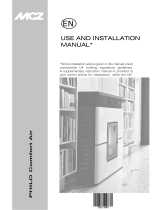N.B.: Method 1 is used to carry out maintenance or
to switch off the stove permanently at the end of the
cold season. Never switch off the stove while it is in
operation, either by cutting off the current at the
plug or at the switch located on the back of the
stove.
This will cause the smoke extractor fan to stop
immediately, causing smoke to issue into the room
if there is no natural upward draught in the chimney.
After switching off the stove on the front panel,
or using the remote control (if this option is
present), wait for 15 minutes cooling time to
elapse before attempting to start again. The
stove may not re-light if it has not cooled
sufficiently.
During the switch-off phase, the smoke extraction
motor continues to run until the stove is cooled,
then switches off automatically. Similarly, the room
air ventilator continues running until the stove has
cooled (the ventilator may switch off and then on
again if there is still some heat in the stove).
SAFETY DEVICES
1. Flue Gas Extraction Motor Failure
If the flue gas extractor stops, a pressure switch
immediately stops the pellet supply.
2. Flue Gas Outlet Safety Device
If the flue gas outlet is obstructed, the pressure
switch prevents fuel from entering the burn pot.
3. Pellet Loading Gear Motor Failure or
Blockage
If the gear motor stops, the stove continues to
operate until it starts to cool down. The system will
attempt to start up the stove, and if the fault persists
the stove will stop completely and lock out.
4. Hot Air Distribution Ventilator Failure
When the temperature at the end of the loader
reaches 105°C, a safety thermostat stops the gear
motor, causing the stove to switch off.
If the thermostat is activated, it must be reset using
the special control (protected by a screw plug) on
the back of the stove under the main switch and
protection fuse.
If the thermostat is actuated again and causes
the stove to stop, contact your service engineer.
5. Temporary Electrical Power Failure
If there is a temporary power failure while the stove
is in operation, the appliance will come on again
automatically. If the power failure is longer lasting,
the smoke extractor stops running and the stove
may therefore emit smoke into the room.
6. Electrical Safety
The stove is protected by a main fuse located on
the rear panel.
CLEANING OF THE STOVE
IMPORTANT: before starting to clean the stove,
check that it is switched off and completely cooled
and that the electrical power supply is
disconnected.
ASHPAN AND BURN POT
WARNING: Do not vacuum hot cinders as they
may cause a fire in the cleaner.
The burn pot must be cleaned every day. Pull it out
manually by lifting, and empty the accumulated ash.
When re-inserting the burn pot, check that it is the
right way round, with the hole for the igniter plug
facing towards the inside of the stove.
Every two or three days, clear the grid at the bottom
of the combustion chamber, take out the drawer,
empty it and replace in the correct position. Finish
off cleaning the inside of the chamber using a
vacuum cleaner. We recommend emptying the
lower ashpan periodically, as described in the
following paragraphs. It may be necessary to
vacuum the small chamber beneath the burn pot.
IMPORTANT: All cleaning and maintenance
operations must be carried out when the stove is
cold. These cleaning operations ensure that the
appliance continues to work efficiently and
correctly. The required frequency of cleaning
operations depends very much on the quality of the
pellets used. We recommend using only tested,
good quality pellets.
After the cold season has ended, the exchanger
must be cleaned. This operation may be required
more often, depending on the pellet quality, but this
should not be considered a sign that the stove is not
functioning correctly.
15
























